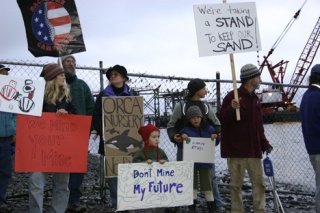More than 50 people turned out for a demonstration at Glacier Northwest’s construction site on Maury Island early Monday morning, chanting and waving handmade placards to voice opposition to an industrial-sized pier and the mammoth mine it would facilitate.
Clad in bulky jackets and wool hats to stave off the early-morning chill, people gathered on a cobble-studded beach next to a cyclone fence the corporation erected over the weekend. Others paddled in kayaks or dinghies, staying far enough from the actual construction operation to avoid arrest.
“It’s reaching a climax, and we really have to step up the amount of intervention here,” Patrick Christie, a University of Washington professor in marine policy, told the group.
“There isn’t one agency ready to oversee this,” Rep. Sharon Nelson (D-Maury) added. “We need eyes and ears on the ground. … We don’t have anybody except for this Island ready to keep an oversight on what happens here.”
The protest took place three days after Glacier began work on the controversial 305-foot pier, a structure that — if completed — could offload millions of tons of gravel onto barges and transform this once small mining operation into the largest in the country.
Much of the protest focused on the role of Public Lands Commissioner Doug Sutherland, the outgoing head of the state Department of Natural Resources who last Tuesday signed Glacier’s 30-year lease. The lease, considered one of the last administrative hurdles for Glacier, gave the corporation permission it needed to build a pier over state-owned aquatic lands, protected by way of the Maury Island Aquatic Reserve.
Sutherland, a Republican, lost in his bid for a third term to Democratic challenger Peter Goldmark. During his re-election campaign, Glacier contributed $50,000 to a political action committee formed for the purposes of supporting Sutherland’s bid for another term.
“Doug Sutherland should be very ashamed of himself,” Amy Carey, the head of Preserve Our Islands (POI), told the group.
At one point, Bill Moyer, the director of the Backbone Campaign, hoisted a bullhorn and yelled, “Is your Island for sale?”
“No!” the crowd answered.
A few minutes later, the group, following Moyer’s lead on the bullhorn, chanted, “Just say no to quid pro quo.”
Two security guards stood on the other sign of the cyclone fence, watching the protest silently. A construction barge, brought to the site less than 24 hours after word of the lease-signing was made public, was in position next to Glacier’s aging pier, and throughout the morning, the long arm of a massive crane could be seen at work.
Dogs barked. Small children stood close to their parents. Every now and then, someone would lead the group in a song. “This land is made for you and me,” the group sang.
The protest, organized by Moyer and others with the Backbone Campaign, seemed in part an effort to keep activists engaged in the now decade-long battle and in part a chance to inform people about the latest development.
In answer to questions, Carey said she and others are trying to figure out what Goldmark can do, if anything, about the lease when he takes over the office in mid-January.
“I think we’re all exploring that,” Carey said.
She also told the group that the fight is not over. POI has already filed an appeal to Glacier’s lease in King County Superior Court and plans to file an injunction in an effort to get an immediate halt in the construction.
“I think they underestimated what they’re dealing with,” she said. “We’re very confident.”
Moyer also used the morning to organize people into letter-writing campaigns, telephone trees and ongoing protests, urging those who raised their hands in answer to his request for support to write their names on various lists he made.
Christie, who as an academic studies citizen participation in aquatic reserves, told the group it was imperative that they not flag in their opposition now.
“I’m inspired by this morning,” he said.
“This is a long process,” he added. “We really need to challenge this, because if people think it’s a done deal, we’ve lost.”
Over the weekend, people noted, several orcas were spotted not far from the Glacier site, evidence, they said, of how critical the foraging areas along the Island are to the health of the imperiled species.
Some of the protesters said that it was because of the orcas that they decided to turn out for the early-morning demonstration.
Islander Margot Boyer stood next to the cyclone fence with a sign sporting striking images of the iconic marine mammals.
“I’m here because of them,” she said. “This population is very endangered. They’re seriously in trouble. This is a stress they can’t handle.”
Dana Schuerholz-Wright concurred, adding, “I’m concerned about our aquifer. I’m concerned about our wildlife. … I’m concerned about the overall impacts.”
Her daughter, 7-year-old Djuna, stood next to her, with a simple, handmade placard.
“Please stop,” it said.



